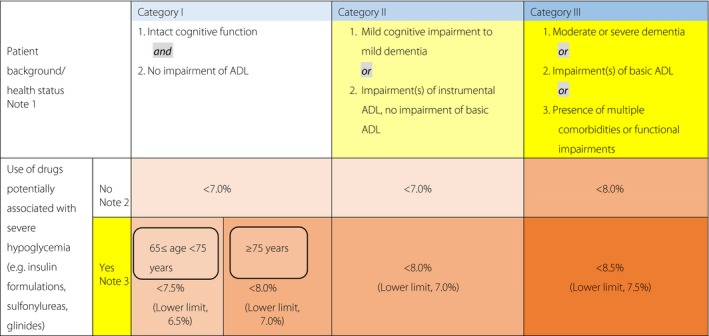Glycemic Targets (HbA1c values) for Elderly Patients with Diabetes. ADL, activities of daily living. The glycemic target is to be determined for each patient by taking into account his/her age, duration of diabetes, risk for hypoglycemia, and any support available to the patient, as well as the patient's cognitive function, basic/instrumental ADL, and comorbidities/functional impairments, if elderly, while noting the potential risk of hypoglycemia that increases with age in each patient. Notes:
Refer to the Japan Geriatrics Society website
9,
10 for the evaluation of the cognitive function, basic ADL (e.g., self‐care abilities such as dressing, transferring, bathing, and toileting), and instrumental ADL (e.g., abilities to maintain an independent household such as shopping, meal preparation, taking medication, and handling finances,). In end‐of‐life care, priority is to be given to preventing significant hyperglycemia and subsequent dehydration and acute complications through appropriate therapeutic measures.
As in other age groups, the glycemic target is set at <7.0% in the elderly for preventing diabetic complications. However, this could be set at <6.0% for those thought likely to achieve glycemic control through diet and exercise therapy alone or those likely to achieve glycemic control with drug therapy without adverse reactions, or 8.0% for those in whom intensifying therapy may prove difficult. In either case, no lower limit is specified for the glycemic target. A glycemic target of <8.5% may be allowed in patients thought to be in category III and therefore at risk of developing adverse reactions to multi‐drug combination therapy or in those with serious comorbidities or poor social support.
In patients in whom priority should be given to preventing the onset/progression of diabetic complications due to their duration of disease, the glycemic target or its lower limit may be set for each elderly patient with appropriate measures in place to prevent severe hypoglycemia. Current treatments are to be continued in those less than 65 years of age despite their HbA1c values falling below their glycemic target or lower limit while on therapy, but care needs to be taken to monitor these patients for potential severe hypoglycemia. Glinides may be classified as drugs unlikely to be associated with severe hypoglycemia, as the onset of severe hypoglycemia varies depending on the type and amount of glinide used in a particular patient relative to the patient's glucose level.
Important precautions Be sure to refer to the ‘Guidelines for Medical Treatment and its Safety in the Elderly’ compiled by the JGS for use of antidiabetic agents in the elderly
11,
12. Every effort should also be made to avoid multi‐drug combination therapy in the elderly and to closely monitor these patients for any adverse reaction to drug therapy.

